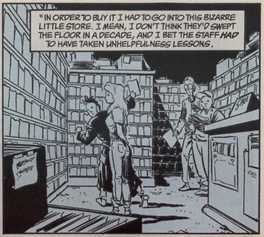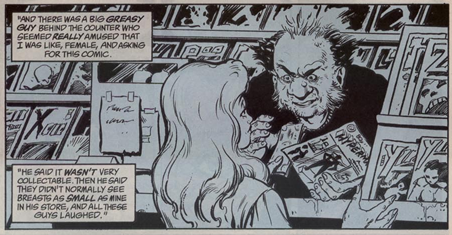|
Riporto qui di seguito l'intervento-introduzione di Gaiman al libro "How to Get Girls (Into Your Store)" un'iniziativa dell'associazione americana Friends of Lulu, che ha come scopo, fra gli altri, quello di avvicinare sempre più donne e ragazze al mondo dei fumetti. Buona lettura! Shameful Secrets of Comics Retailing: The Lingerie Connection Several years ago, I wrote a scene in a comic (it was Sandman 37, the last chapter of the book A Game of You) in which a young lady went into a comic shop for the first time to buy a comic. Here are the panel descriptions I wrote back then: PAGE 20 PANEL 2
Barbie cap: "In order to buy it I had to go into this bizarre little store. I mean, I don't think they'd swept the floor in a decade, and I bet the staff had to have taken unhelpfulness lessons." PAGE 20 PANEL 3
Barbie caps: "And there was big greasy guy behind the counter who seemed really amused that I was like, female, and asking for this comic. "He said it wasn't very collectable. Then he said they didn't normally see breasts as small as mine in his store, and all these guys laughed." The scene was ably and accurately drawn by Shawn McManus, who depicted the comic shop in question as a claustrophobic, rather dirty place, with a leering and unwashed gentleman behind the counter staring at the discomfited heroine. We got two different kinds of reaction from that scene, in readers' letters, and afterwards. Three (male) readers wrote in to complain that nothing like this ever happens in life, that the comic shop we had depicted was purely and only the product of Shawn and my fevered brains, all-too-obviously corrupted by some kind of strange bleeding-heart feminist urge to blacken the public face of comics retailers. And dozens of (female) readers wrote in to say, all of them in more or less the same way, and at the same volume "That's exactly what it's like." "HOW DID YOU KNOW?" The point that the male correspondents seemed to miss was not that all comics stores are like that, but that some are—some subtly, many not-so subtly. There are comics stores out there that are simply boys' clubs, owned or run by people who've never been much good at talking to or being in the presence of women, and, for that matter, have never quite mastered basic woman-friendly skills, like washing, changing their tee-shirts, or sweeping the floor. Women feel as uncomfortable in these places as most men do when inexorable circumstances cause them, blushing, coughing and staring nervously at the store, to spend any amount of time in the lingerie department of a large department store. THIS IS NOT GOOD. Lingerie departments exist to serve only half the human race (and a small handful of fetishists). The other half of us will only stumble in there more or less at gunpoint, looking for birthday presents (or, worse, accompanying a grandmother on the scent of a pre-war foundation garment), and stare around us desperately, then, unable to meet the eyes of the saleslady, will sidle out, embarrassed somehow managing to convince ourselves that our wives or girlfriends will be just as happy with a power tool (or we sit, drumming our feet and wishing we were elsewhere until elderly female relations have made their purchases). Comics, unlike lingerie, is not a gender-specific product. Women, after all, buy more books than men do. They like to read. And there is no X-chromosome-linked inability to read comics, either. When I was a boy, in England, I tended to prefer my cousin's and sisters' girls' comics to the blander fare that boys got, because the stories were better. (They may have tended to be about virtuous young ladies being ill-treated by vicious step-families, their only friend the cheerful young stable-boy, but they were stories, dammit. They were going somewhere.) But there were two points that I was making in the Sandman panels I mentioned above. One was that, often, the stores themselves were less than women-friendly. The other was that the material on sale often has as little interest for women as the aforementioned lingerie, when not actually being worn by an object of desire, has for most men. Sometimes comics retailers come over to me, and grin. "I want to thank you for bringing women into my store!" they say, happily. Sandman was in the minority of comics whose readers, based on whatever unscientific measures one can use to measure these things (in this case, readers' letters and the genders of people turning up for signings) seemed, after the first year or so, pretty much evenly divided between men and women. When interviewers would ask me why that was, I used to tell them it was because women liked real stories about people, and that was undoubtedly part of it. The other part of it was probably that the women in Sandman (and there were a lot of them) were there neither for decoration nor to appeal to the glandular needs of pubertal readers; they didn't get tied to chairs wearing nothing but their lingerie ("If I were a female comic character," wrote Alan Moore in his 1982 essay "Invisible Girls and Phantom Ladies," talking about this tendency, "I think I'd be inclined to dress up warm, wear three pullovers at once and never go anywhere without a pair of scissors."); neither were they six-gun wielding huge breasted gals who were, in effect, guys in unconvincing drag. I'm not claiming here that Sandman was perfect, or alone in the world of comics in its depiction of women. Obviously neither statement is true. My point is that, given a comic with a story that was not actually offensive, and comic stores that did not actually drive women away, we soon would have a significant, word-of-mouth-driven female readership—and comics retailers selling comics to an expanded customer base. Which is good for everyone. At the time I write this, the world of comics is in the kind of depression that tends to provoke comments like "Well, at least it can't get any worse" from people in all branches of the industry, just before it goes and does just that. This volume, published and compiled by Friends of Lulu, is here to help all of you sell more comics. You are selling people dreams and stories and pictures, and there's never been anything gender-specific about them. You have, after all, nothing to lose but fifty percent of the human race. Neil Gaiman June 11, 1997 |
 BLACK AND WHITE FLASHBACK PANEL. BARBIE'S STANDING IN A COMIC-BOOK STORE. IT'S A REALLY SMALL, DIRTY ONE. SHE'S STANDING LOOKING SLIGHTLY SCARED. ON THE STAND BEHIND HER IS A TYPICAL ASSORTMENT OF EROS-STYLE PORNO COMICS COVERS, SHOWING WOMEN WITH TITANIC BREASTS IN BONDAGE AND SO FORTH; AND, BELOW THAT, WE'VE GOT A WHOLE SHELF OF JUST THE SAME COMIC WITH THE SAME COVER -- OR MAYBE A WHOLE SET OF THE SAME COMIC WITH DIFFERENT COVERS. IT'S GOT TO BE CALLED SOMETHING LIKE THRUST FORCE #1, AND IT'S YOUR OPPORTUNITY TO PASTICHE—NOT PARODY—A SET OF X-MEN TYPE COVERS. MUSCULAR MEN AND WOMEN WITH TOWERING BOOBS AND NOT MUCH COVERING THEM. MAYBE IN THE BACKGROUND OR AT THE SIDE WE CAN SEE TWO OR THREE FOURTEEN YEAR OLD BOYS, JUST SORT OF STARING AT HER. THIS IS NOT A NICE COMIC STORE-- IT'S THE KIND OF PLACE THAT MAKES YOU FEEL OILY AND GREASY, AND MAKES YOU WISH YOU WERE SOMEWHERE ELSE.
BLACK AND WHITE FLASHBACK PANEL. BARBIE'S STANDING IN A COMIC-BOOK STORE. IT'S A REALLY SMALL, DIRTY ONE. SHE'S STANDING LOOKING SLIGHTLY SCARED. ON THE STAND BEHIND HER IS A TYPICAL ASSORTMENT OF EROS-STYLE PORNO COMICS COVERS, SHOWING WOMEN WITH TITANIC BREASTS IN BONDAGE AND SO FORTH; AND, BELOW THAT, WE'VE GOT A WHOLE SHELF OF JUST THE SAME COMIC WITH THE SAME COVER -- OR MAYBE A WHOLE SET OF THE SAME COMIC WITH DIFFERENT COVERS. IT'S GOT TO BE CALLED SOMETHING LIKE THRUST FORCE #1, AND IT'S YOUR OPPORTUNITY TO PASTICHE—NOT PARODY—A SET OF X-MEN TYPE COVERS. MUSCULAR MEN AND WOMEN WITH TOWERING BOOBS AND NOT MUCH COVERING THEM. MAYBE IN THE BACKGROUND OR AT THE SIDE WE CAN SEE TWO OR THREE FOURTEEN YEAR OLD BOYS, JUST SORT OF STARING AT HER. THIS IS NOT A NICE COMIC STORE-- IT'S THE KIND OF PLACE THAT MAKES YOU FEEL OILY AND GREASY, AND MAKES YOU WISH YOU WERE SOMEWHERE ELSE.